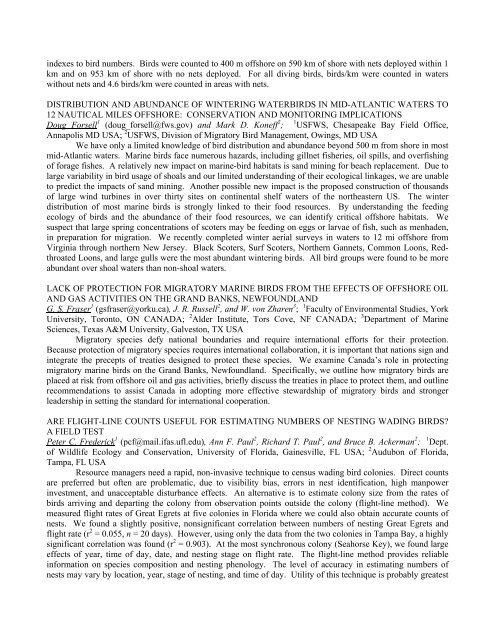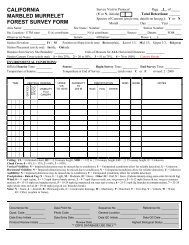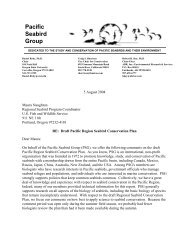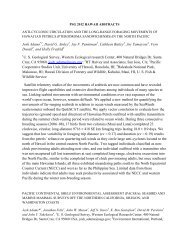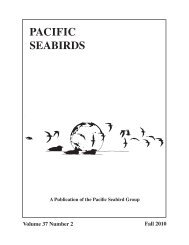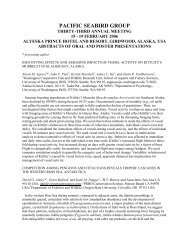abstracts of oral and poster presentations - Pacific Seabird Group
abstracts of oral and poster presentations - Pacific Seabird Group
abstracts of oral and poster presentations - Pacific Seabird Group
You also want an ePaper? Increase the reach of your titles
YUMPU automatically turns print PDFs into web optimized ePapers that Google loves.
indexes to bird numbers. Birds were counted to 400 m <strong>of</strong>fshore on 590 km <strong>of</strong> shore with nets deployed within 1<br />
km <strong>and</strong> on 953 km <strong>of</strong> shore with no nets deployed. For all diving birds, birds/km were counted in waters<br />
without nets <strong>and</strong> 4.6 birds/km were counted in areas with nets.<br />
DISTRIBUTION AND ABUNDANCE OF WINTERING WATERBIRDS IN MID-ATLANTIC WATERS TO<br />
12 NAUTICAL MILES OFFSHORE: CONSERVATION AND MONITORING IMPLICATIONS<br />
Doug Forsell 1 (doug_forsell@fws.gov) <strong>and</strong> Mark D. Koneff 2 ; 1 USFWS, Chesapeake Bay Field Office,<br />
Annapolis MD USA; 2 USFWS, Division <strong>of</strong> Migratory Bird Management, Owings, MD USA<br />
We have only a limited knowledge <strong>of</strong> bird distribution <strong>and</strong> abundance beyond 500 m from shore in most<br />
mid-Atlantic waters. Marine birds face numerous hazards, including gillnet fisheries, oil spills, <strong>and</strong> overfishing<br />
<strong>of</strong> forage fishes. A relatively new impact on marine-bird habitats is s<strong>and</strong> mining for beach replacement. Due to<br />
large variability in bird usage <strong>of</strong> shoals <strong>and</strong> our limited underst<strong>and</strong>ing <strong>of</strong> their ecological linkages, we are unable<br />
to predict the impacts <strong>of</strong> s<strong>and</strong> mining. Another possible new impact is the proposed construction <strong>of</strong> thous<strong>and</strong>s<br />
<strong>of</strong> large wind turbines in over thirty sites on continental shelf waters <strong>of</strong> the northeastern US. The winter<br />
distribution <strong>of</strong> most marine birds is strongly linked to their food resources. By underst<strong>and</strong>ing the feeding<br />
ecology <strong>of</strong> birds <strong>and</strong> the abundance <strong>of</strong> their food resources, we can identify critical <strong>of</strong>fshore habitats. We<br />
suspect that large spring concentrations <strong>of</strong> scoters may be feeding on eggs or larvae <strong>of</strong> fish, such as menhaden,<br />
in preparation for migration. We recently completed winter aerial surveys in waters to 12 mi <strong>of</strong>fshore from<br />
Virginia through northern New Jersey. Black Scoters, Surf Scoters, Northern Gannets, Common Loons, Redthroated<br />
Loons, <strong>and</strong> large gulls were the most abundant wintering birds. All bird groups were found to be more<br />
abundant over shoal waters than non-shoal waters.<br />
LACK OF PROTECTION FOR MIGRATORY MARINE BIRDS FROM THE EFFECTS OF OFFSHORE OIL<br />
AND GAS ACTIVITIES ON THE GRAND BANKS, NEWFOUNDLAND<br />
G. S. Fraser 1 (gsfraser@yorku.ca), J. R. Russell 2 , <strong>and</strong> W. von Zharen 3 ; 1 Faculty <strong>of</strong> Environmental Studies, York<br />
University, Toronto, ON CANADA; 2 Alder Institute, Tors Cove, NF CANADA; 3 Department <strong>of</strong> Marine<br />
Sciences, Texas A&M University, Galveston, TX USA<br />
Migratory species defy national boundaries <strong>and</strong> require international efforts for their protection.<br />
Because protection <strong>of</strong> migratory species requires international collaboration, it is important that nations sign <strong>and</strong><br />
integrate the precepts <strong>of</strong> treaties designed to protect these species. We examine Canada’s role in protecting<br />
migratory marine birds on the Gr<strong>and</strong> Banks, Newfoundl<strong>and</strong>. Specifically, we outline how migratory birds are<br />
placed at risk from <strong>of</strong>fshore oil <strong>and</strong> gas activities, briefly discuss the treaties in place to protect them, <strong>and</strong> outline<br />
recommendations to assist Canada in adopting more effective stewardship <strong>of</strong> migratory birds <strong>and</strong> stronger<br />
leadership in setting the st<strong>and</strong>ard for international cooperation.<br />
ARE FLIGHT-LINE COUNTS USEFUL FOR ESTIMATING NUMBERS OF NESTING WADING BIRDS<br />
A FIELD TEST<br />
Peter C. Frederick 1 (pcf@mail.ifas.ufl.edu), Ann F. Paul 2 , Richard T. Paul 2 , <strong>and</strong> Bruce B. Ackerman 2 ; 1 Dept.<br />
<strong>of</strong> Wildlife Ecology <strong>and</strong> Conservation, University <strong>of</strong> Florida, Gainesville, FL USA; 2 Audubon <strong>of</strong> Florida,<br />
Tampa, FL USA<br />
Resource managers need a rapid, non-invasive technique to census wading bird colonies. Direct counts<br />
are preferred but <strong>of</strong>ten are problematic, due to visibility bias, errors in nest identification, high manpower<br />
investment, <strong>and</strong> unacceptable disturbance effects. An alternative is to estimate colony size from the rates <strong>of</strong><br />
birds arriving <strong>and</strong> departing the colony from observation points outside the colony (flight-line method). We<br />
measured flight rates <strong>of</strong> Great Egrets at five colonies in Florida where we could also obtain accurate counts <strong>of</strong><br />
nests. We found a slightly positive, nonsignificant correlation between numbers <strong>of</strong> nesting Great Egrets <strong>and</strong><br />
flight rate (r 2 = 0.055, n = 20 days). However, using only the data from the two colonies in Tampa Bay, a highly<br />
significant correlation was found (r 2 = 0.903). At the most synchronous colony (Seahorse Key), we found large<br />
effects <strong>of</strong> year, time <strong>of</strong> day, date, <strong>and</strong> nesting stage on flight rate. The flight-line method provides reliable<br />
information on species composition <strong>and</strong> nesting phenology. The level <strong>of</strong> accuracy in estimating numbers <strong>of</strong><br />
nests may vary by location, year, stage <strong>of</strong> nesting, <strong>and</strong> time <strong>of</strong> day. Utility <strong>of</strong> this technique is probably greatest


